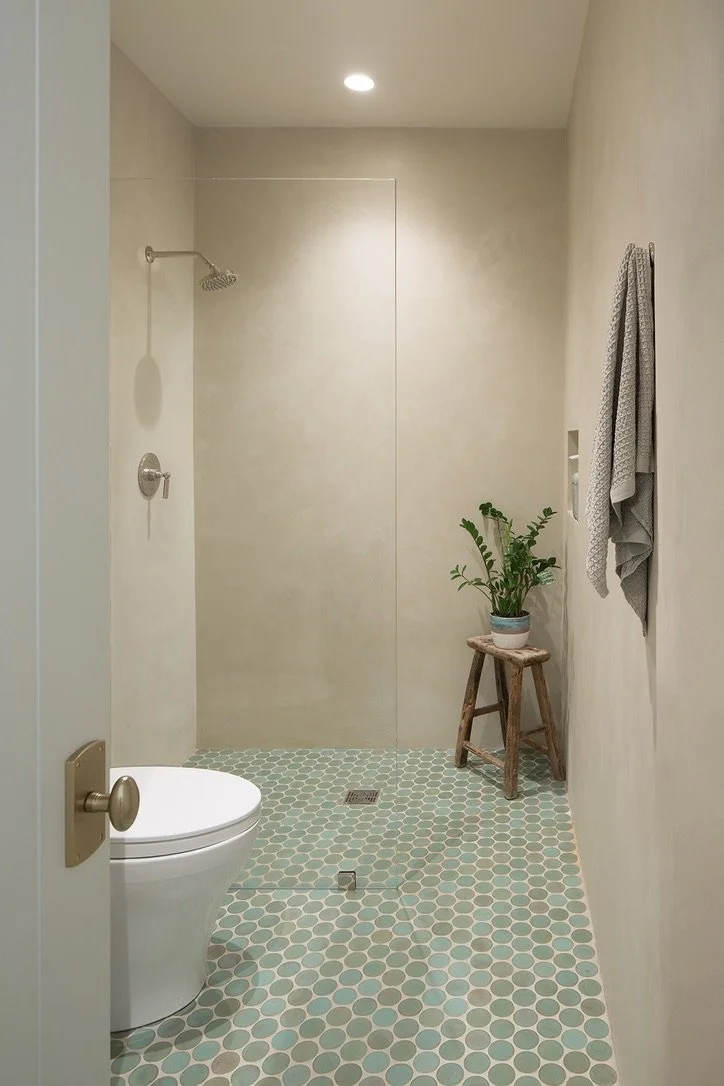
Tadelakt: water-resistant, polished lime plaster
Tadelakt is a beautiful, unique, and charming finish. It is silky and sensuous, lending itself to a very custom look. It creates a surface that feels like ceramic, without the grout lines. Technically, tadelakt is an ancient Moroccan technique for making polished, water-resistant plaster finishes. Traditionally, tadelakt was made entirely from lime plaster, polished and sealed with an oil-based soap. In the US, the term “tadelakt” is diluted, now used to describe a wide range of polished plasters.
There are many products on the market that describe themselves as tadelakt. Many of them rely on resins and/or cement to achieve the look of traditional tadelakt. Some people interested in this look are not concerned about what the plaster is made of, but we are not in that camp. Coming from our background of sustainable building, we choose to install lime-based tadelakt only. The products we use are sourced and manufactured in the USA by Earthaus Mineral Finishes, who declare all of the ingredients.
Although it is gorgeous, tadelakt does come with some caveats that are important to understand before selecting it as your finish.
Variability: Tadelakt is a natural and hand-applied material that can be unpredictable, resulting in variations in tone and color throughout the surface: no two tadelakt walls will look exactly the same. If you are someone who embraces the wabi-sabi of natural stone or wood, you will appreciate the variability and unique beauty of tadelakt.
Character: Tadelakt can darken and show micro-cracks when it gets wet. These tiny cracks are part of the nature of the material. Since the true waterproofing is taken care of behind the tadelakt surface, these tiny cracks — that appear when wet and disappear again when dry — are not a cause for concern and can be appreciated as part of the tadelakt experience.
Cost and Inconvenience: Tadelakt is an expensive, labor-intensive process with long drying/curing times. Installation of a tadelakt shower will require 5-7 days of labor with additional curing time before the shower can be used.
Durability and Repairability: Like tile or stone, traditional tadelakt can be scratched or chipped and is not an easy surface to repair. It can be stained by things like oil or red wine. It requires some maintenance, such as resealing every year.
“Wet tadelakt” vs “Splash tadelakt”
For clarity, we divide tadelakt into two categories: “wet tadelakt” which is a special water-resistant plaster that can be used in a shower or as a tub surround vs. “splash tadelakt” which is a plaster that is resistant enough to be used for a backsplash but doesn’t need the water-resistance of a shower.
*** If you are interested in “splash tadelakt,” you can skip the rest of this discussion, which focuses on “wet tadelakt” for a shower or tub surround. ****
In showers, we install a modernized version of tadelakt based on the ancient Moroccan technique of polished lime plaster. It retains the beauty, sensuousness, and material purity of traditional tadelakt while meeting current building codes.
This pure, lime-based system we use has no VOCs, is better for indoor air quality, and has a lighter environmental footprint than other modern systems that rely on resins and/or cement as binders. Although we adhere to more of the traditional materials, it would be a stretch to say that what we install is traditional Moroccan Tadelakt.
To meet modern building codes, the system has evolved from the ancient technique of building up layers of lime that relied solely on the polished surface of the plaster for its water resistance to a system where waterproofing is installed behind the plaster. The plaster is polished to be water-resistant but it is not the true waterproofing layer..
This lime-based system creates a wall similar to a natural marble slab. That means:
• It is a firm but relatively soft material that is resistant to dents but can be damaged with sharp objects or enough blunt force.
• It is difficult to repair seamlessly. Repairs can sometimes require sanding down a whole wall and re-plastering.
• It will stain if exposed to standing water over time. Any areas that darken and stay dark after use should be addressed quickly to prevent permanent staining.
• Tadelakt is water-resistant but it is not water-proof. The true waterproofing of a shower is done behind the Tadelakt layers. Small cracks in the surface of the Tadelakt may appear darker when wet but will fade when dry. Larger cracks, chips, or dents should be addressed promptly to prevent staining.
• Wet objects left touching the plaster can leave permanent stains over time, such as bottles on shelves, leaving rings.
• Tadelakt can stain if exposed to strongly colored liquids like hair dyes or red wine.
• It can be damaged by harsh chemicals, acidic soaps, or abrasives. Only mild soap, water, and a cloth should be used for cleaning.
• Just like squeegeeing down shower glass, Tadelakt walls benefit from being wiped down with a soft cloth after use. This prevents soap scum and hard water minerals from accumulating on the surface.
• Tadelakt should be resealed yearly for best durability.
A serene soaking tub with a traditional tadelakt surround
Tadelakt can vary in tone like natural stone
One of our clients learning to re-waxing her traditional tadelakt
Tadelakt is a beautiful, tactile, unique finish that some people just have to have despite its quirks. If you understand the nature and limitations of tadelakt and must have it anyway, get in touch with us to discuss your project.






